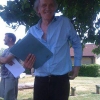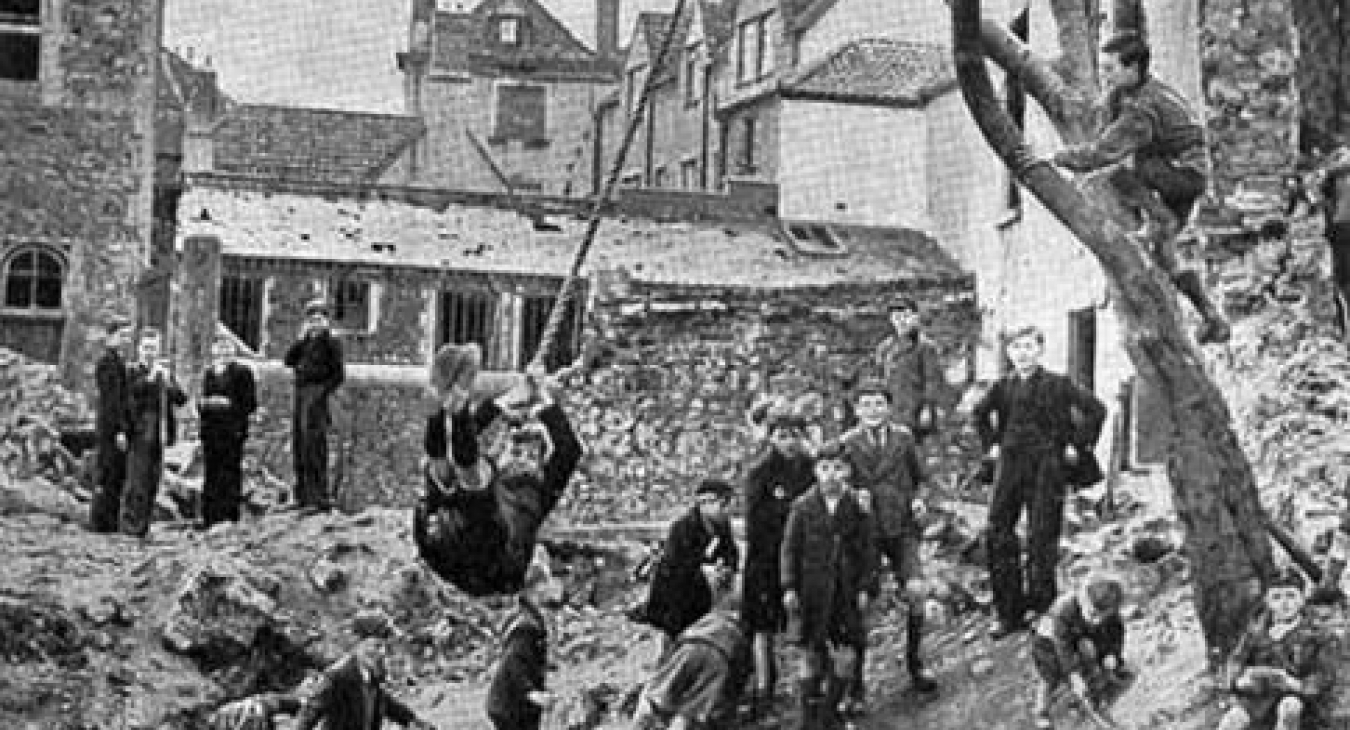Playgrounds must provide a safe environment where each child can grow in confidence, self-esteem, and abilities. History tells us that children have always played from time immemorial in ancient Greek, Renaissance, and Biblical cultures. These are well documented: "And the streets were full of children playing thereof." Zechariah 8:5. As early as the 5th Century B.C., Greek artists created vase paintings that captured children swinging on swings, according to www.kidscreations.com.

"Children's Games," by 16th century Flemish artist Pieter Bruegel the Elder, shows over 200 children playing at least 80 different games including horse racing, leapfrog, tug-of-war, horsey play, spinning tops, balancing on barrels, knucklebones, dress-up games, playing musical instruments, and blowing bubbles. The Dorset visionary poet, William Barnes, highlighted the importance of play and foretold the future dangers possible from the loss of the child’s world of play in this extract from an early 19th century poem, The Leane:
The children will soon have no place
For to play in and if they do grow,
They will have a thin mushroom face
With’ their bodies so supple as dough.
But a man is made of a child,
And his limbs do grow work some by play
And if the young child’s little body’s a-spoiled,
Why, the man’s will the sooner decay.
But the greens be a-grudged, for to rear
Our young children up healthy and sound,
Why there will not be left in the next age
A green spot where their feet can go free
Unsupervised commercial playgrounds were first created in the UK by Charles Wicksteed. His factory was in the process of removing some surplus central heating pipes and these were left out overnight as a treat for local children to play with the following day. The children created play equipment out of these items making swings, slides, and seesaws out of the metal poles, chains and planks. Wicksteed was amazed by what he witnessed and saw the commercial possibilities. Consequently, the children's playgrounds he later designed became the forerunner of those of today.
In 1939, following the evacuations of London's children from the city prior to the Blitz of the second world war, no one thought that they'd be bored with the countryside. Missing their communities, many of them made their own way home, two to three thousand returning weekly. They joined thousands of children who had remained there, considered too disruptive to be evacuated. By the time the German bombers started their bombing of the city, thousands of these children were there in the midst of it all.

With schools closed, fathers in the forces, mothers at work, groups of children spent their days on the streets in undisciplined and unsupervised play. Yet within these groups, there was an inner self-discipline. They created playgrounds and dens using salvaged timber from the rubble left from the attacks. As the bombs fell all around them, they seemed to be totally oblivious to all of the dangers and risks. Many shared their treasures of timber and artifacts with their peers.
There were national concerns over these children at the time; the public believing that they would suffer from trauma with the effects of the bombing. This led to Marie Paneths employment with the Branch street project. Marie believed play had a healing effect if children could create their own playgrounds where so much damage occurred. She advocated junk playgrounds with supervision and, eventually, she ran a junk playground children built out of salvaged materials.
One group of the many city bomb site children was led by a youth named Patsy Duggan. Patsy's gang was nicknamed the ‘Dead End Kids.’ Soon they became unofficial fire fighters, with their tools, buckets of sand, rope, and axes. They assisted other rescue service workers, pulling people from burning buildings. However, despite the risks, they were never appeared traumatised.

In Copenhagen, Carl Theodor Sorensen, who was Emdrup’s planner of orthodox playgrounds, had observed children illegally playing on the nearby dangerous building sites. They were taking full advantage of the endless play possibilities which these sites offered, with all their building materials of sand, gravel, water, cement, bricks and tools. As a result, Sorenson suggested experimenting with these so-called junk playgrounds, later incorporating them into the Danish housing associations parks. This experiment started the junk playground phenomena which was to have a profound effect on play provision throughout Europe in future years.
At Sorenson's Emdrup playground there were only bricks, boards, timber posts, planks, saws, and hammers. Hundreds of children dug, played with sand, water or fire. Here they built houses with hinged doors and locks, decorating them with flowers, tables, chairs and kitchen items, all under the watchful eyes of the German soldiers of occupation.
While travelling from England to lecture in Norway in 1946, Marjorie Allen's plane stopped in Copenhagen. She visited the Emdrup junk playground and was swept off her feet by what she saw. In a flash of understanding, she realized that she was looking at something new and full of possibilities. Later she published an article in the popular Picture Post magazine which highlighted the Emdrup junk playground and brought the subject to the attention of the general public.
After the war the cities were full of bombed sites. Hordes of children swarmed over them, using all the materials available, like bricks, timber, metal, tools and equipment, creating junk playgrounds. These ‘playgrounds’ also were full of hidden dangers, from jagged metal to unexploded bombs.

Some children fought over these spoils of war and were seen by the public as juvenile delinquents. A.S. Neil, of Summerhill’s free school, wrote a letter to the London Times on the matter of juvenile delinquency. His letter was swiftly responded to by Marjorie Allen and was a catalyst for her adventure playgrounds campaign. She believed that town planners expensive mechanical playgrounds built on asphalt and concrete were not a children’s paradise as they claimed. She felt that swinging backwards and forwards on swings were of utter boredom to children; it was little wonder they much preferred playing on bomb sites.
These adventure junk playgrounds with supervision were seen as an answer to delinquency and to offset the high rate of accidents and casualties of children affected by the hostile busy and growing traffic. With so many dangerous roads, many children were now becoming imprisoned in their local communities, unable to cross the busy roads and with nowhere to play safely. A campaign steering committee was hurriedly formed which included, amongst others, the National Playing Fields Associations consisting of Lord Luke, Drummond Abernethy, and Marjorie Allen. They met at Play Field House in London to look into the possibility of providing adventure playgrounds in all the major cities of the UK. Soon government legislation was introduced for conversion of many of the bombed sites into adventure playgrounds, with seventeen grant-aided trial sites to be run by voluntary bodies.

Adventure playgrounds grew in number and popularity from the late fifties and, in more recent decades, in cities, new towns, and urban areas. Here children played on wooden structures, swung from Tarzan ropes, scampered up commando nets, and jumped from aerial runways. They tested their own capabilities in risk-taking activities and developed building skills, becoming adept at using tools and a wide range of materials. They built flimsy dens at first, but then their constructions became more imaginative and structurally sound. Play structures were constructed by play workers and youth volunteers for use as climbing frames, towers, walkways, slides, aerial runways, Tarzan rope swings, and commando netting. These were made from a vast variety of wood timbers from many sources. These included telegraph poles, railway track wooden sleepers, wooden beams from demolished buildings and railway stations, timber from demolition sites, shuttering boards used from foundations of motorways and timber off-cuts from Forestry commission sawmills, and so on. A vast range of timber was donated from factories and warehouses such as wooden pallets/duckboards from Bowater's etc.
Children were encouraged to take risks through means of a wide variety of play pursuits, including the construction work themselves with the use of tools and materials. Some of the playgrounds had gardens, pet areas, barbecue communal seating areas, nursery areas, pre- school groups and youth sections. They were a community of children of all ages, play workers, and parents.
Hundreds of these adventure playgrounds were established nationally over many decades throughout the UK, thanks to the work of the National Playing Fields Association, Marjorie Allen, play bodies, play workers and play associations. They were managed by a variety of groups including local play associations, local councils, social services or leisure departments, new town development corporations and voluntary bodies such as Barnardos, UK's largest children's charity. Some of these adventure playgrounds were lost over time due to housing redevelopment, or insufficient funding, while others survived up to 60 years. Over time, thousands and generations of children have passed through their gates and enjoyed the adventure playground experience.
Throughout history children have of course played in a vast variety of ways and environments despite their social circumstances in peace or war. For it is in their very nature to play and they cannot help but play. Whether particular places are provided for them in the community, (such as community playgrounds. play spaces or school playgrounds) or not. Children easily adapt at a very young age whether playing in groups or alone and solitary. They play wherever they happen to be at the time, using their imagination and inventiveness to make the best of any given situation, as an opportunity.

Despite the often harsh play environments of concrete tarmac surfaces on barren school playgrounds and urban alleyways, generations of children have developed and amassed a rich and complicated collection of group and team games, played with balls, and skipping rope rhymes, all handed down from previous generations. Many of these have been catalogued by Peter and Iona Opie. Other children played their traditional ad hoc games of soccer on any available piece of wasteland using jumpers or coats as goalposts.
In the early 1960s, a report by town and country planning called for the need for special play places for all children close to their homes. This resulted in town planners taking child’s play provision more seriously and fully into account. With this provision, a variety of unsupervised play spaces, including toddler play space, sprang up close to residential areas and in communities within housing estates. These were attractive colourful areas, though problems evolved later over the years with vandalism, poor maintenance and safety issues being prominent. With the dangers of falls onto tarmac or concrete, these playgrounds became a real problem. They were highlighted in Charles Rudds Playleader National Association Recreation Leaders magazine, showing horrific photos of dangerous, rusty, jagged metal play equipment. Such playground equipment had been responsible for thousands of injuries to children nationally.
Numerous public campaigns were initiated by Safety on Playgrounds Action group and similar voluntary committees, such as the National Playing Fields Association /Fair Play For Children's Safety committee, led by Donne Buck and Peter Heseltine and supported by Paul Rose MP and TV personality Esther Rantzen. A great deal of public concern and fears of insurance claims eventually led to changes in the law. Safety surfaces on play areas were introduced and becoming a reality in the UK. Attractively coloured playgrounds with safety designed play surfaces of sand, bark or rubber matting soon sprang up nationally in communities throughout the UK. These were vast improvements from the original tarmac and concrete playgrounds surfaces of the past. Though often, particularly in the USA, these are placed far too close to housing and, as a result, children's natural play enjoyment is curtailed by rules. Rules which are displayed on many of these play areas include no noise, or running; excitable fun is not permitted. This prohibition of natural noisy play activity associated with the excitement normally associated with child's play is contrary to the total concept of quality play provision. The old maxim was in effect, children must be seen but not heard.

The playground adventurous look and concept of the modern park playground is so often portrayed today as actually being an "Adventure Playground.” There are a variety of unsupervised styles including heavy weight, wooden, or plastic materials, walkways, towers, runways, slides, commando nets, and rubber, wood mulch, or sandy safe surfaces. These large fort-type commercial playgrounds of today are poor imitations of adventure playgrounds, despite looking exciting, attractive and challenging, with slides, climbing apparatus and walkways. They contain no loose parts, often many have limited space for movement of children to run under, between or above, with no bouncy-board flooring to play chase or similar enjoyable pursuits. There are no varieties of timber here as most are made of extremely hard wood with no apparent give, bounce or texture. Here there is little opportunity for the more adventurous child to meet challenges, overcome obstacles and for coming to terms with risks. Though in many ways it is truly a compliment to the original adventure playground ideal that it has been so sweetly imitated by the commercial manufacturer.
These playgrounds meet the prescribed needs of the risk-free Health and Safety insurance laws. Yet in reality, they are in many ways not fully child-friendly play environments. There are concerns over the rubber matting which heats in the summer sunshine, is thought to give off toxicity, and is felt to cause more serious injuries on impact than either bark or sand. In fact, the rate of injuries on playgrounds has hardly changed since the initial use of safety surfaces which is extremely worrying and very disappointing.
Healthy children are eager to take many risks and leap into the unknown daily. It's how children overcome problems and learn about themselves and the world around them. The more we take risks out of their play experiences, the more we limit their ability to experience life to the fullest.

Summary
Over generations, children's play has been affected and influenced by dramatic changes in their natural world through the effects of wartime, housing demolition, and redevelopment, as well as in their daily environments at schools with bare concrete tarmac playgrounds and often hostile dangerous streets. Children’s swing parks were often exciting but also often dangerous and poorly maintained with their heavy metal, fixed play equipment. Children's familiar play places over the years have included bombed sites and derelict wasteland within demolished housing, often amongst junk and rubble. Those more fortunate have had access to country environments and, of course, some have had access to local adventure playgrounds. Yet despite all the many constraints and restrictions on their full free play experience, children have adapted well, using play in all its varied forms as a positive means to socially enrich their lives in constructive ways, to overcome and deal with their circumstances. Through their play, they have managed to enjoy their lives and have fun. They still have fun today, despite the safety measures of the supposedly risk-free, social constraints imposed by adults, whether well-meaning, safety-conscious parents, council officials, recreation experts or law makers. Children cannot help but play, for it is in their very nature to do so. Attempts to put limitations on their natural play through whatever means is contrary to nature and limits the child's growth and social development. This ultimately leads to future mental, social, and fitness issues in later life, as is well documented by numerous child psychologists.








balsall heath playground
my email is [email protected]
great to hear from you. aYes
great to hear from you. Yes i was first leader there in 69 my email is raywills(at)mail.com
Play
Hi Raymond,
I enjoyed reading your article about risk in play and the history of adventure playgrounds. i still work at St. Paul's Trust which was one of the original adventure playgrounds. I was wondering if you had apart to play in this site? it is on Malvern street. It's more or less all gone now which is so sad. I have been running holiday playschemes for 30 years and in this time have witnessed the cleansing of children's play. We try and keep it going but have been sued for our efforts! We still have the city farm - just about - and the play areas for the kids. But now we provide childcare and holiday schemes when we can get the funding. i would love to develop the playground again and build amazing adventure things for the kids. Time is running out for me, we are sinking with lack of funding. It would be greta to hear from you,
all the best
Add new comment